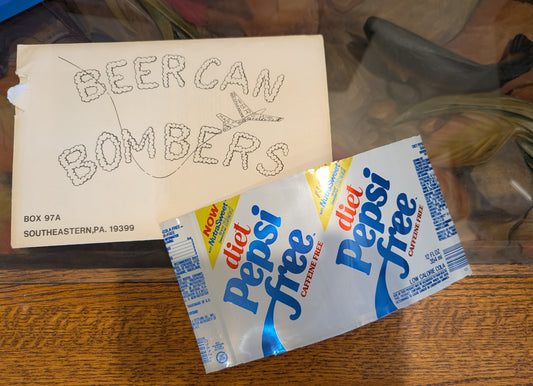Colección: Beer Can Bombers
My grandfather, Roland Mayer, created the original beer can bombers, also known as soda can flyers. I found some of the kits dating back decades in the basement. It would be fun to share the kits with the world. My grandfather loved all things aviation and started selling model plane patterns from ads in the back of magazines as a hobby. When we visited as a kid, he had many different models strung up and hanging from the ceiling around his house.
INTRODUCTION
The use of thin, rugged aluminum in modern day beer and soft drink containers has provided a free, easily worked structural material for constructing high performance flight models.
Your kit provides a full size pattern for a hand launched glider, that can be constructed easily, in less than a hour from a discarded aluminum can. It includes a soft vinyl safety nose cap, modelling clay for balancing and high strength transparent tape for root joint reinforcement. No other materials are required except the aluminum blank from your favorite beverage container.
No special tools are required and within reason the design is relatively forgiving and does not require a high degree of manual skill or a precisely finished product.
The finished glider flies well because of its light weight and is extremely rugged and amenable to repeated adjustment for changing flight patterns. It is ideal for hands-on flight experience, understanding of why airplanes fly, how they are controlled and just plain fun.
In addition to the pattern, illustrated instructions cover procedures from preparing the empty can to flight adjustments on the finished model.
GENERAL FABRICATION
Care should be exercised in handling the thin metal, but because of the relative softness of aluminum, when cut, it does not produce the razor sharp edges that could be expected with equivalent tin (steel) cans. It is therefore not particularly hazardous to work.
The aluminum is easily cut with common scissors (equivalent to stiff paper) or can be scored by razor or exacto knife and then cracked along score lines.
Bending and forming is simple and can be accomplished mostly with finger pressure. For accuracy, however, all bends should be made against a straight edge, ruler, vice jaw, table edge, etc., and some clamping force applied to prevent slippage.
-
Beer Can Bombers, Acrobat
Precio habitual $5.00 USDPrecio habitualPrecio unitario / por
